Are you looking to expand your guitar chord vocabulary and tackle the F# major chord? Often pronounced “F sharp major,” this chord can be a bit tricky for beginners, especially when approached as a full barre chord. While you might be tempted to opt for its minor counterpart, F#m, mastering the F# major opens up a world of musical possibilities.
This guide will walk you through the most common way to play the F# chord – the barre chord version – as well as an easier alternative that’s perfect for players just starting out. We’ll break down each method step-by-step, offering tips and practice exercises to help you play the F# chord with confidence and clarity.
The Standard F# Barre Chord
The most frequently taught version of the F# chord utilizes the barre chord technique. It’s essentially the same hand shape as an E major chord, but shifted up two frets, with your index finger acting as a barre across the 2nd fret.
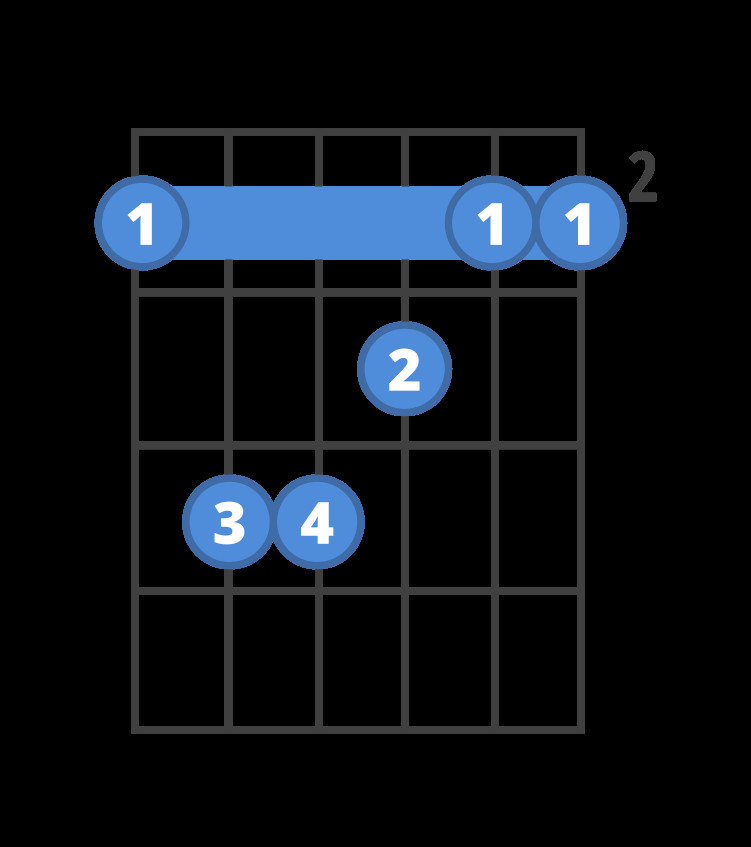 Chord diagram for the Gb guitar chord.
Chord diagram for the Gb guitar chord.
Beginner Tip: If barre chords are new to you, feel free to jump to the easier version below and come back to this one later.
How to Play the Barre Chord F
-
Create the Barre: Place your index finger across all six strings of the guitar at the 2nd fret. Ensure the edge of your finger is flat against the strings, just behind the fret. This barre is crucial for cleanly playing all the notes of the chord.
-
Form the E Shape: Using your remaining fingers (middle, ring, and pinky), create the familiar shape of an E major chord right behind your index finger. Your middle finger goes on the 3rd string (G string) at the 3rd fret, your ring finger on the 5th string (A string) at the 4th fret, and your pinky finger on the 4th string (D string) at the 4th fret.
-
Strum and Adjust: Strum all six strings. If you hear buzzing or muted strings, it means you need to adjust your finger pressure. Barre chords often require more finger strength, especially when you’re starting out.
Tips for Playing the F# Barre Chord
- Focus Barre Pressure: Concentrate the pressure of your index finger on the thicker low E string and the thinner high E string. You can slightly curve your finger to achieve this, applying more pressure where needed.
- Think E Major Shape: Mentally connect this F# barre chord to the E major chord shape you already know. This association can help you remember finger placement and improve your muscle memory.
- Consider the Easier Version: If you find the full barre F# challenging, don’t get discouraged! The easier “small barre” version explained below is an excellent alternative and still produces a full and rich F# major sound.
- Practice in Short Bursts: Barre chords can be tiring on your fretting hand initially. Practice in shorter intervals and take breaks to avoid strain. Consistency is key!
The Beginner-Friendly F# Chord (Small Barre)
For guitarists who are new to barre chords or prefer a less strenuous option, there’s a fantastic alternative F# chord using a “small barre.” This version is easier to play and still sounds like a complete F# major chord.
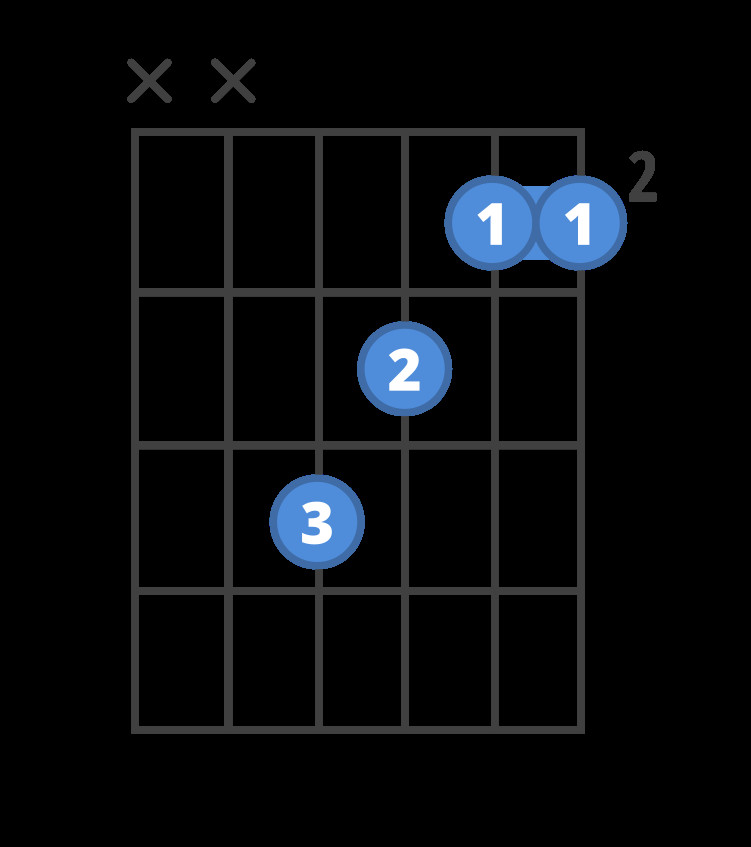 Chord diagram for the Gb guitar chord.
Chord diagram for the Gb guitar chord.
Need help reading chord diagrams? Check out our guide on how to read guitar chord diagrams for a quick tutorial.
This version still incorporates a barre, but it’s a much smaller one, only covering the thinnest two strings at the 2nd fret. This significantly reduces the hand strength and pressure required for a clean sound.
How to Play the Easier F# Chord
-
Small Barre on Top Strings: Use your index finger to barre across just the thinnest two strings (1st and 2nd strings – high E and B strings) at the 2nd fret. These strings are close together and require less pressure than a full barre.
-
Add Middle and Ring Fingers: Stretch your middle and ring fingers to the 3rd and 4th frets respectively. Place your middle finger on the 3rd string (G string) at the 3rd fret and your ring finger on the 4th string (D string) at the 4th fret.
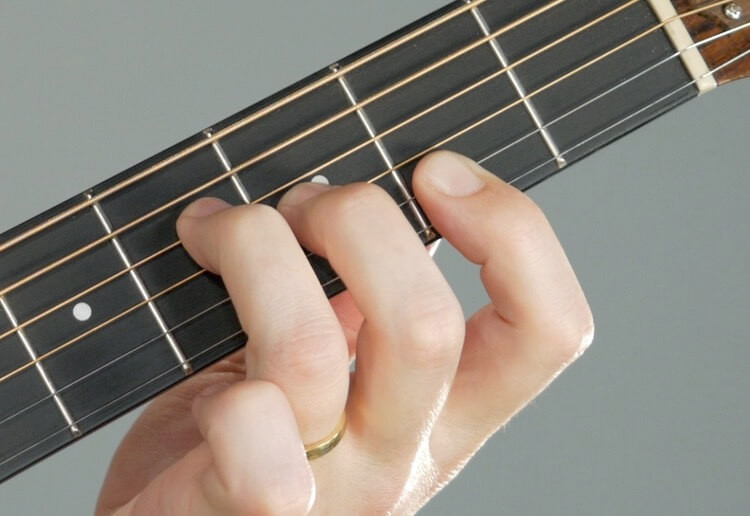 Close-up of fingers forming the small barre F sharp major chord.
Close-up of fingers forming the small barre F sharp major chord. -
Strum Four Strings: Firmly press down with your fretting hand fingers and strum only the thinnest four strings (1st to 4th strings). Avoid strumming the lower E and A strings for this voicing.
Benefits of the Small Barre F
- Easier on Fingers: Requires less hand strength and finger pressure compared to the full barre version, making it ideal for beginners or those with hand fatigue.
- Quick to Learn: The smaller barre is less daunting to master, allowing you to play an F# chord sooner in your learning journey.
- Still Sounds Great: While it uses fewer strings, this version still captures the essence of the F# major chord and works well in many musical contexts.
Practicing the F# Chord
Barre chords might seem intimidating at first, but with the right approach, they become manageable. Anna Freitas’s excellent video series can [demystify barre chords]([invalid URL removed]) and provide valuable tips for smoother transitions and eliminating fret buzz.
To solidify your F# chord and integrate it into your playing, here are some effective practice exercises:
Chord Transitions: E to F
Start by practicing switching between the open E major chord and the F# major barre chord. This exercise helps you understand the relationship between the two shapes and builds muscle memory for moving to the F# barre.
E Major
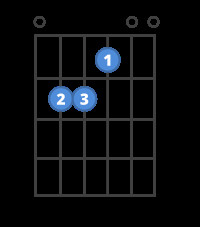 Chord diagram for the E guitar chord.
Chord diagram for the E guitar chord.
F# Major
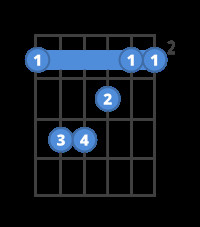 Chord diagram for the F sharp guitar chord.
Chord diagram for the F sharp guitar chord.
Practicing this transition will help you internalize how the F# barre chord originates from the E major shape, just moved up the neck.
Practice Tip: Use Smart Flashcards to train your chord changes between E and F# with interactive feedback.
Similar Chord Shapes: F# and Bm
Another effective practice method is to focus on chords that share similar shapes. The B minor (Bm) chord uses the same barre chord shape as F#, but shifted down one string set. Practice transitioning between F# major and B minor to become comfortable with this shape across the fretboard.
F# Major
 Chord diagram for the F sharp guitar chord.
Chord diagram for the F sharp guitar chord.
B Minor (Bm)
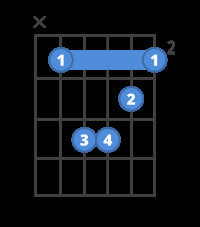 Chord diagram for the Bm guitar chord.
Chord diagram for the Bm guitar chord.
Mastering the transition between F# and Bm enhances your barre chord dexterity and prepares you for moving barre chord shapes around the neck.
Practice Tip: Utilize Smart Flashcards for F# and Bm to make this practice interactive and track your progress.
Chords in the Key of B: F#, E, B, and C#m
Expand your practice by incorporating chords commonly used with F# major within the key of B major. These include B major, C# minor (C#m), and E major. Practicing these chords together will help you understand how F# functions musically and improve your chord vocabulary in a practical context.
F# Major
 Chord diagram for the F sharp guitar chord.
Chord diagram for the F sharp guitar chord.
E Major
 Chord diagram for the E guitar chord.
Chord diagram for the E guitar chord.
B Major
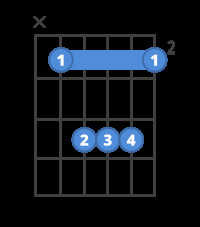 Chord diagram for the B guitar chord.
Chord diagram for the B guitar chord.
C# Minor (C#m)
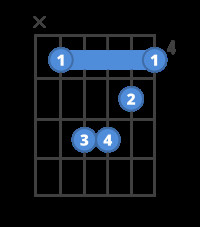 Chord diagram for the C sharp minor guitar chord.
Chord diagram for the C sharp minor guitar chord.
Practicing these chord progressions not only strengthens your F# chord but also develops your musical ear and understanding of chord relationships.
Practice Tip: Use Smart Flashcards for F#, E, B, and C#m to practice these key chords interactively.
As you practice, pay attention to the musicality of these chord changes. You might even recognize familiar song progressions! Take breaks to simply play and explore the sounds you’re creating. Remember, it’s called playing guitar for a reason!
Make Practice Fun with Games
To make your F# chord practice more engaging, try incorporating guitar practice games. ChordBank offers games that use your guitar’s sound as input, turning chord practice into an interactive and enjoyable experience.
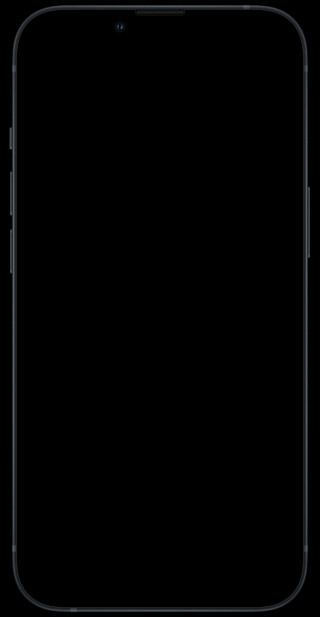 iPhone displaying ChordPop! guitar practice game.
iPhone displaying ChordPop! guitar practice game.
 iPhone displaying ChordPop! guitar practice game.
iPhone displaying ChordPop! guitar practice game.
Games like ChordPOP! or Blast-o-chords listen to your guitar playing through your device’s microphone and react to your chord changes. This gamified approach can make practicing chords, including the F# major, more motivating and effective.
Game Recommendations:
- ChordPOP!: F#, E, and Bm: Pop balloons by playing the correct chords!
- Blast-o-chords: F#, Bm, E, and C#m: Create explosions and mayhem by playing chords accurately!
By exploring both the barre chord and easier versions of the F

